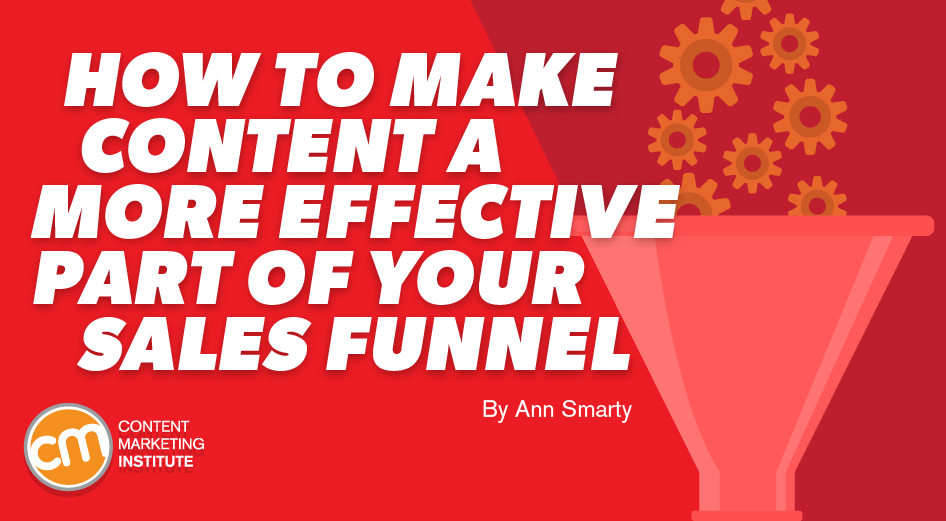 Unless you go an extra mile integrating your content ideation and creation processes into your sales funnel, your content may never bring in sales despite high search rankings and lots of traffic.
Unless you go an extra mile integrating your content ideation and creation processes into your sales funnel, your content may never bring in sales despite high search rankings and lots of traffic.
In this case, completing that extra mile requires only five steps, from ideation to CTAs and format.
1. Match content ideas to your value proposition
What is it you are selling? Which problems are your products solving? Build your content ideation and keyword research processes around that.
Not every “relevant” keyword is worth pursuing if there’s no way to tie it to your value proposition. The best content idea is the one that connects a searchable keyword with the product(s) your brand offers:

It is not a bad idea to integrate your products into your keyword spreadsheets. Add a column to note which products or product features could be mentioned in the piece of content:

When you group or cluster your keywords, use your products as one of the criteria.
2. Build content in a problem-solution format
What questions are people asking when they search using a particular keyword? What problems are they experiencing?
Your content should solve those problems and answer those questions.
Content structure is one of the most effective ways to boost conversions. Break your content into logical sections. Answer all the questions relevant to the section. Visitors will be drawn deeper and deeper into your content, making them more willing to trust your brand and ultimately buy.
#Content structure is one of the most effective ways to boost conversions, says @SEOSmarty via @CMIContent. #SEO Click To Tweet
Google’s People Also Ask is a great way to find those problems to address in your content: It is also a good idea to use FAQ schema to generate rich snippets in search results to get a higher click-through rate, as shown below in the click option to answer “What is the most powerful laptop in the world?” and “What should I look for when buying a powerful laptop?”

3. Optimize for search intent
Search intent reflects why users are likely searching for something. In most cases, people search to buy, get informed, or go somewhere. Your page needs to give them that opportunity.
Search intent optimization is key to converting readers into buyers, but don’t forget search intent may evolve based on how well your copy is written and structured.
Note how Lowe’s links to their products at the beginning of its article on how to paint kitchen cabinets, making it clear everything is ready for the buyer to take action:

Creating text to match and transform that intent is fundamental to successful intent optimization. Text Optimizer is my go-to tool because it helps me understand which concepts and subtopics are expected from content on a particular topic, such as this one for growing indoor plants:

Use intent optimization tools to ensure your content matches the searcher’s expectations and then create contextual CTAs to transform that expectation and drive an action (see the first step in this article).
4. Get creative with contextual CTAs
After creating content that delivers on the visitor’s intent, integrate calls to action that match the intent, such as:
- List products from your site people can use to follow the steps.
- Include a discount or promotional offer.
- Ask them to sign up for a newsletter to get exclusive offers, etc.
Vcita lets you create customizable and contextual CTA widgets:

You can customize to identify the pages where the widget should appear, which allows you to better match your widget CTA to the page topic and content type.
Finteza allows users to create personalized CTAs based on the first page the visitor landed on, their referral source, or even a previous action they performed on the site. You can choose which pages of your site should those ads be served and how long that campaign should run:

These great WordPress plugins also make CTAs easy to integrate into your content.
Enabling your visitors to schedule a demo or a sales call often shortens the buyer journey. Tools like Appointfix (now called Goldie) integrate well in content and allow visitors to click once to request a call.

Finally, consider an in-content form instead of a traditional CTA. Conversational Forms, which I have found the most engaging, lets visitors answer a question before a new question appears. It’s designed to feel more like a one-on-one interaction than an institutional form completion.
Stop using institutional field completion forms. A tool like Conversational Forms from @easywpforms lets visitors answer a question before a new question appears, says @SEOSmarty via @CMIContent. #SEO Click To Tweet5. Create videos
Finally, to make the most of your content creation in the buyer journey, create more videos. Between 37% and 47% of buyers prefer to engage with and learn more about a brand through video.
Videos also will make your products more findable through YouTube and carousels on Google and other platforms.

Creating videos help acquire new customers as well as close more sales. Any time you are working on an article, ask yourself if there’s a video creation opportunity there.
HANDPICKED RELATED CONTENT:
Build a content bridge to sales
From attracting links to driving brand awareness, content can be a useful tool for every step in the sales funnel. But, if you take a few more steps beginning in the planning stage, crafting content and CTAs that relate to a visitor’s intent can also drive direct sales.
The author selected all tools mentioned in this article. If you’d like to recommend a tool, please include it in the comments.
Cover image by Joseph Kalinowski/Content Marketing Institute

